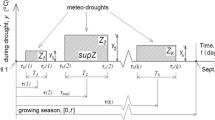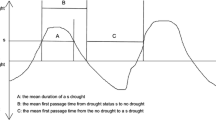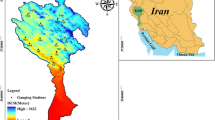Abstract
Extreme changes in weather across the globe are substantially responsible to incite calamities like drought. While we cannot control weather, it is a harsh reality that we cannot stop droughts. However, the consequent detriments can discerningly be reduced to a tolerable limit by developing long term rational planning. To attain this objective, probability models are imperative as they measure and analyze the variation in the random phenomena in an orderly way and help to collect useful information leading toward meaningful predictions. In this paper, an explicit distribution based on the convolution of stochastic variables is derived from the Bivariate Affine-Linear Exponential (BALE) distribution to model the interarrival time of drought. The proposed model follows the trend of the observed drought data of the Colorado Drainage Basin in the USA that provides the rationale for its reliable forecasting. The return periods are also estimated for the interarrival time of drought to obtain important inferences for future planning. Finally, some quantiles associated with this model are provided, which are useful to predict changes in the interarrival times of droughts.



Similar content being viewed by others
References
Alley WM (1984) The Palmer Drought Severity Index: limitations and assumptions. J Appl Meteorol climatol 23:1100–1109
Anshuka A, van Ogtrop FF, Vervoort RW (2019) Drought forecasting through statistical models using standardized precipitation index: a systematic review and meta-regression analysis. Nat Hazards 97:955–977
Austin SH, David LN (2017) Modeling Summer Month Hydrological Drought Probabilities in the United States Using Antecedent Flow Conditions. J Am Water Resour Assoc (JAWRA) 53(5):1133–1146. https://doi.org/10.1111/1752-1688.12562
Blom G (1958) Statistical estimates and transformed beta-variables. Wiley, New York
Bonaccorso B, Cancelliere A, Rossi G (2003) An analytical formulation of return period of drought severity. Stoch Enviro Res Risk Assess 17:157–174
Bras RL (1990) Hydrology: an introduction to hydrologic science. Addison-Wesley, Reading
Chambers J, Cleveland W, Kleiner B, Tukey P (1983) Graphical methods for data analysis. Chapman and Hall, London
Cheng KS, Hou JC, Liou JJ, Wu YC, Chiang JL (2010) Stochastic simulation of bivariate gamma distribution: a frequency-factor based approach. Stoch Environ Res Risk Assess 25(2):107–122
Douglas EM, Vogel RM, Kroll CN (2002) Impact of streamflow persistence on hydrologic design. J Hydrol Eng 7(3):220–227
Dupuis DJ (2010) Statistical modeling of the monthly Palmer Drought Severity Index. J Hydrol Eng 15(10):796–808
Foster LM, Bearup LA, Molotch NP, Brooks PD, Maxwell RM (2016) Energy budget increases reduce mean streamflow more than snow-rain transitions: using integrated modeling to isolate climate change impacts on Rocky Mountain hydrology. Environ Res Lett 11:1–10. https://doi.org/10.1088/1748-9326/11/4/044015
Guerrero-Salazar P, Yevjevich V (1975) Analysis of drought characteristics by the theory of runs. Hydrology Paper No.80, Colorado State University, Fort Collins.
Gupta RD, Kundu D (1999) Generalized exponential distribution. Aust N Z J Stat 41:173–188
Haan CT (1977) Statistical methods in hydrology. Lowa State University Press, Ames
Hallack-Alegria M, Watkins DW Jr (2007) Annual and warm season drought Intensity-Duration-Frequency analysis for Sonora. M J Clim 20(9):1897–1909
Han P, Wang P, Tian M, Zhang S, Liu J, Zhu D (2013) Application of the ARIMA Models in Drought Forecasting Using the Standardized Precipitation Index. Comput Comput Technol Agric, VI 392:352–358
Hao Z, Singh VP (2011) Bivariate drought analysis using entropy theory. Symposium on Data-Driven Approaches to drought 43, http://docs.lib.purdue.edu/ddad2011/43.
Heim RR (2002) A review of twentieth-century drought indices used in the United States. Bull Am Meteor Soc 83:1149–1165
Henningsen A, Toomet O (2011) maxLik: A package for maximum likelihood estimation in R. Comput Stat 26:443–458
Jacobi J, Perrone D, Duncan LL, Hornberger G (2013) A tool for calculating the Palmer drought indices. Water Resour Res 49:6086–6089
Jain VK, Pandey RP, Jain MK, Byun H-R (2015) Comparison of drought indices for appraisal of drought characteristics in the Ken River Basin. Weather Clim Extrem 8:1–11
Jamro S, Dars GH, Ansari K, Krakauer NY (2019) Spatio-temporal variability of drought in Pakistan using standardized precipitation evapotranspiration index. Appl Sci 9:4588
Jamro S, Channa FN, Dars GH, Ansari K, Krakauer NY (2020) Exploring the evolution of drought characteristics in balochistan. Pak Appl Sci 10:913
Liu X, Wang S, Zhou Y, Wang F, Li W, Liu W (2015) Regionalization and spatiotemporal variation of drought in china based on standardized precipitationevapotranspiration index (1961–2013). Adv Meteorol. https://doi.org/10.1155/2015/950262
Lloyd EH (1970) Return period in the presence of persistence. J Hydrol 10(3):202–215
Loaiciga HA, Marino MA (1991) Recurrence interval of geophysical events. J Water Resour Plan Manage 117(3):367–382
Madadgar S, Moradkhani H (2013) A Bayesian Framework for Probabilistic Seasonal Drought Forecasting. J Hydrometeorol 14(6):1685–1705
Marshall AW, Olkin I (1967) A multivariate exponential distribution. J Am Stat Assoc 62:30–44
McCabe GJ, Wolock DM, Pederson GT, Woodhouse CA, McAfee S (2017) Evidence that Recent Warming is Reducing Upper Colorado River Flows. Earth Interactions, EI-D-17–0007.1 https://doi.org/10.1175/EI-D-17-0007.1.
Mishra AK, Singh VP (2010) A review of drought concepts. J Hydrol 391:202–216
Mishra AK, Singh VP (2011) Drought modeling: a review. J Hydrol 403:157–175
Mohsin M, Pilz J, Spöck G, Ahsanullah M (2010) On some new bivariate pseudo-Gamma distribution. J Appl Stat Sci 18(2):239–250
Mohsin M, Gebhardt A, Pilz J, Spöck G (2013) A new bivariate Gamma distribution generated from functional scale parameter with application to drought data. Stoch Env Res Risk Assess 27(5):1039–1054
Mohsin M, Kazianka H, Pilz J, Gebhardt A (2014) A new bivariate exponential distribution for modeling moderately negative dependence. Stat Methods Appl 23(1):123–148
Nadarajah S (2007) A bivariate gamma model for drought. Water Resour Res 43:W08501. https://doi.org/10.1029/2006WR005641
Nadarajah S (2008) The bivariate F distribution with application to drought data. Statistics 42(6):535–546
Nadarajah S (2009) A bivariate Pareto model for drought. Stoch Environ Res Risk Assess 23:811–822
Prudnikov AP, Brychkov YA, Marichev OI (1986) Integrals and Series, vol 1. Gordon and Breach Science Publishers, Amsterdam
Razmkhah H (2017) Comparing threshold level methods in development of stream flow drought severity-duration-frequency curves. Water Resour Manage 31:4045–4061
Regoli G (2009) A class of bivariate exponential distribution. J Multivar Anal 100:1261–1269
Sarhan AM, Balakrishnan N (2007) A new class of bivariate distributions and its mixture. J Multivar Anal 98:1508–1527
Shiau JT (2003) Return period of bivariate distributed hydrological events. Stoch Environ Res Risk Assess 17:42–57
Shiau J, Shen HW (2001) Recurrence analysis of hydrologic droughts of differing severity. J Water Resour Plan Manage 127(1):30–40
Solander KC, Bennett KE, Middleton RS (2017) Shifts in historical streamflow extremes in the Colorado River Basin. J Hydrol: Reg Stud 12:363–377. https://doi.org/10.1016/j.ejrh.2017.05.004
Song S, Singh VP (2010) Frequency analysis of droughts using the Plackett copula and parameter estimation by genetic algorithm. Stoch Environ Res Risk Assess 24(5):783–805
Tian L, Quiring SM (2019) Spatial and temporal patterns of drought in Oklahoma (1901–2014). Int J Climatol 39:3365–3378
Tillman FD, Gangopadhyay S, Pruitt T (2020) Trends in recent historical and projected climate data for the Colorado River Basin and potential effects on groundwater availability: U.S. Geological Survey Scientific Investigations Report 2020–5107, 24 https://doi.org/10.3133/sir20205107.
U.S. Bureau of Reclamation, 2012: Colorado River basin water supply and demand, executive summary, 28 p.
Udall B, Overpeck J (2017) The 21st Century Colorado River Hot Drought and Implications for the Future. Accept Water Resour Res. https://doi.org/10.1002/2016WR019638
Vogel RM (1987) Reliability indices for water supply systems. J Water Resour Plan Manage 113(4):645–654
Wang L, Zhang X, Wang S, Salahou MK, Fang Y (2020) Analysis and application of drought characteristics based on theory of runs and copulas in Yunnan, Southwest China. Int J Environ Res Pub Health 17(13):4654
Woodhouse CA, Pederson GT, Morino K, McAfee SA, McCabe GJ (2016) Increasing influence of air temperature on upper Colorado River streamflow. Geophys Res Lett. https://doi.org/10.1002/2015GL067613
Yevjevich V (1967) An Objective approach to definitions and investigations of continental hydrologic drought. Hydrology paper No. 23, Colorado State University, Fort Collins.
Yu H, Qiang Z, Chong-Yu X, Juan D, Peng S, Pan H (2019) Modified Palmer drought severity index: model improvement and application. Environ Int 130:104951
Zhang S, Wu Y, Sivakumar B, Mu X, Zhao F, Sun P, Han J (2019) Climate change-induced drought evolution over the past 50 years in the southern Chinese Loess Plateau. Environ Model Software 122:104519. https://doi.org/10.1016/j.envsoft.2019.104519
Acknowledgement
The authors are thankful to the reviewers for their valuable comments and suggestions which certainly helped to improve the paper.
Author information
Authors and Affiliations
Corresponding author
Ethics declarations
Conflict of interest
The authors declare that there is no conflict of interest.
Additional information
Publisher's Note
Springer Nature remains neutral with regard to jurisdictional claims in published maps and institutional affiliations.
Appendices
Appendix 1
Case | Non-drought duration (months) | Drought duration (months) |
|---|---|---|
1 | 15 | 10 |
2 | 12 | 3 |
3 | 3 | 10 |
4 | 5 | 39 |
5 | 8 | 16 |
6 | 4 | 9 |
7 | 48 | 10 |
8 | 3 | 2 |
9 | 17 | 10 |
10 | 14 | 5 |
11 | 26 | 28 |
12 | 31 | 6 |
13 | 19 | 4 |
14 | 3 | 5 |
15 | 53 | 6 |
16 | 5 | 11 |
17 | 8 | 2 |
18 | 2 | 7 |
19 | 2 | 21 |
20 | 7 | 16 |
21 | 2 | 3 |
22 | 21 | 17 |
23 | 20 | 12 |
24 | 4 | 6 |
25 | 4 | 7 |
26 | 7 | 7 |
27 | 24 | 8 |
28 | 8 | 5 |
29 | 2 | 19 |
30 | 6 | 3 |
31 | 2 | 7 |
32 | 5 | 26 |
33 | 4 | 10 |
34 | 16 | 15 |
35 | 8 | 16 |
36 | 7 | 25 |
37 | 5 | 2 |
38 | 14 | 16 |
39 | 16 | 4 |
40 | 2 | 3 |
41 | 31 | 8 |
42 | 17 | 11 |
43 | 7 | 9 |
44 | 5 | 15 |
45 | 5 | 5 |
46 | 8 | 6 |
47 | 5 | 11 |
48 | 71 | 19 |
49 | 4 | 18 |
50 | 3 | 3 |
51 | 9 | 5 |
52 | 19 | 9 |
53 | 13 | 3 |
54 | 2 | 6 |
55 | 23 | 2 |
56 | 2 | 4 |
57 | 6 | 59 |
58 | 14 | 8 |
59 | 8 | 9 |
60 | 3 | 9 |
61 | 7 | 15 |
62 | 10 | 25 |
63 | 13 | 7 |
64 | 9 | 2 |
65 | 2 | 6 |
66 | 3 | 20 |
67 | 9 | 18 |
Appendix 2
Proof 1
Using the transformations \(S = X + Y\) and \(W = \frac{X}{X + Y}\) in (3), the joint density of S and W becomes.
Using (8), the pdf of S can be written as
Using Mathematica and simplifying, we get (4).
To derive the moments of S, we need the following lemma:
Lemma 1
Prudnikov et al. (1986) [vol. 1, Eq. (2.3.6.9), p-324]. If \(a,b \in {\mathbb{R}},\,\,s > 0\,\) and \(\,|\arg \,c| < \pi ,\)
where \(\Psi \left( . \right)\) is Kummer’s (confluent hypergeometric) function of second kind which is given by
Now the product moment of the distribution proposed in (1) is obtained as:
Using Lemma 1 and further simplifying we arrive at
Putting \(\alpha = 1,\) we get from (9)
Proof 2
The result follows by writing \(E\left( {S^{n} } \right) = E\left( {X + Y} \right)^{n} = \sum\limits_{k = 0}^{n} {\left( {\mathop {}\limits_{k}^{n} } \right)} E\left( {X^{k} Y^{n - k} } \right)\) and applying (10) to each expectation in the sum, we get the result stated in (5).
Rights and permissions
About this article
Cite this article
Mohsin, M., Pilz, J. Stochastic model for drought analysis of the Colorado River Basin. Stoch Environ Res Risk Assess 35, 1637–1648 (2021). https://doi.org/10.1007/s00477-021-01989-z
Accepted:
Published:
Issue Date:
DOI: https://doi.org/10.1007/s00477-021-01989-z




